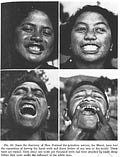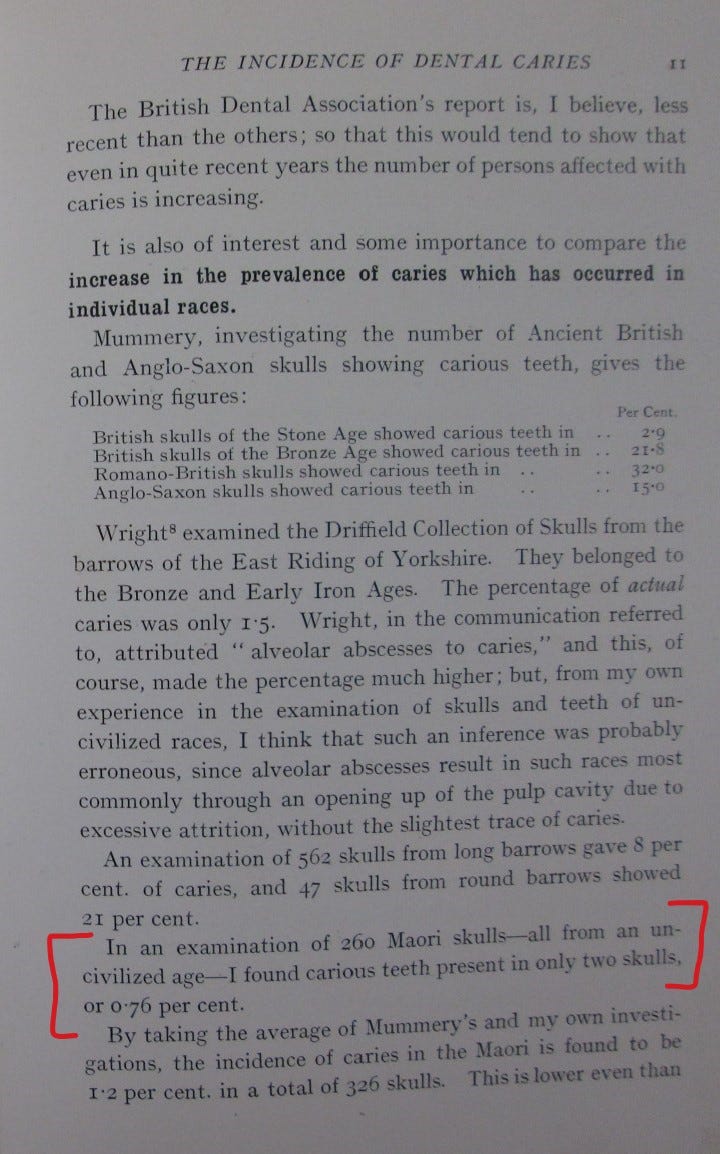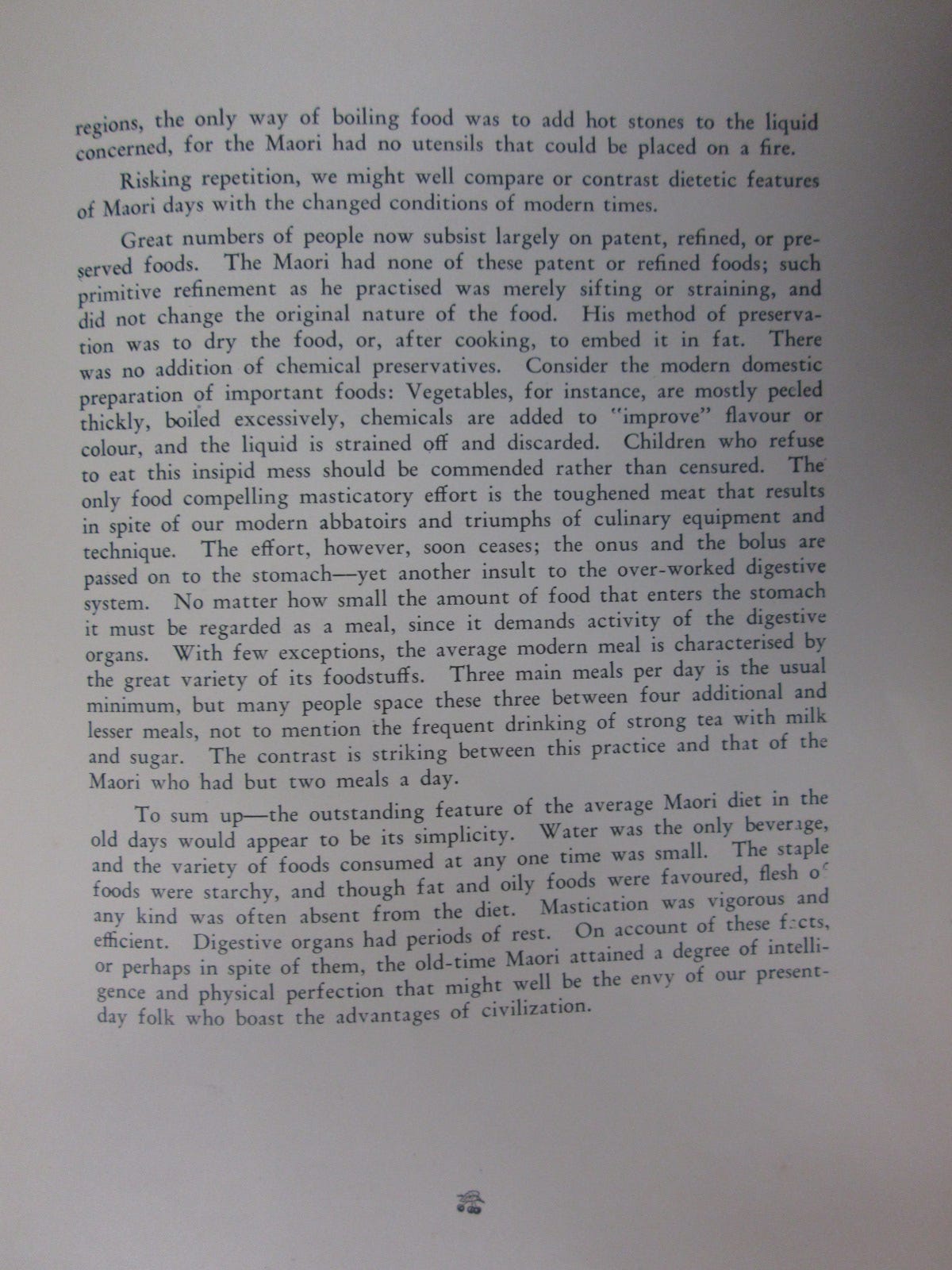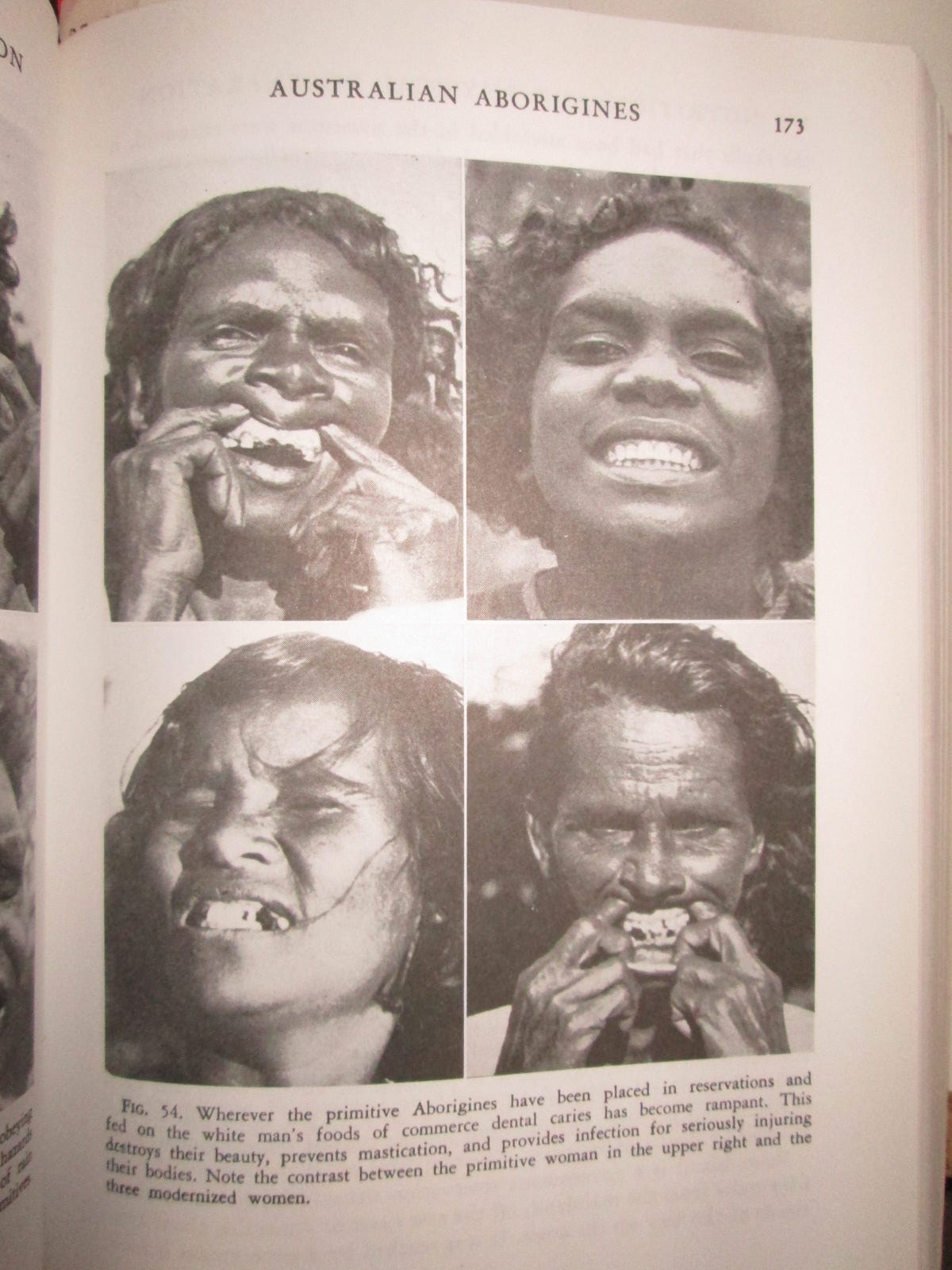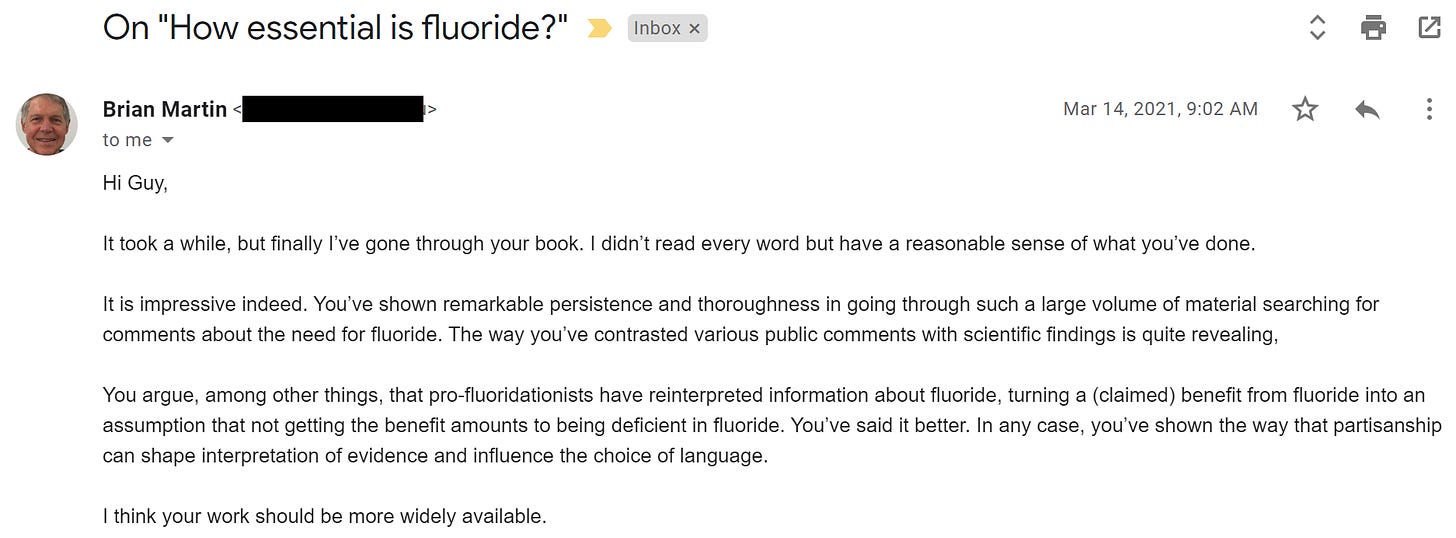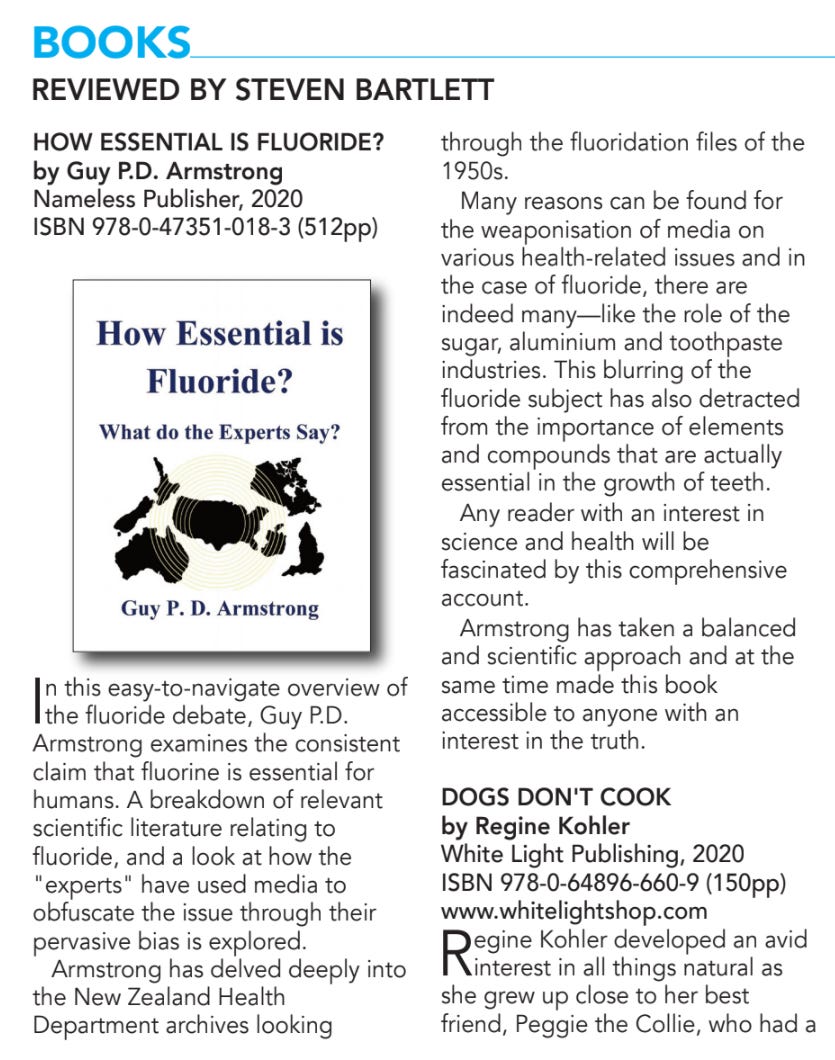Dental health of NZ Maori prior to use of refined food
This ad was on my facebook "Guy Armstrong Author Page" in late 2021
In terms of teeth, pre-colonization Māori were some of the healthiest people in the world, according to Dr. John Howard Mummery (British Medical Association President 1914), Dr. henry Pickerell DDS (Otago University New Zealand), Dr. Weston Price (Ohio, USA), and Dr. R. M. S. Taylor DDS (New Zealand).
That the work and claims of these men is difficult to find in much modern and even decades-old academic work is a demonstration that our thinking, like our dental arches, has narrowed a long time ago, and stays that way.
Dr. Price’s work on the topic of indigenous health is no doubt the finest, most detailed and most expansive of the four I’ve mentioned.
In the 1920s and 1930s when he investigated indigenous health, many indigenous peoples were still living away from the colonizers, and this allowed Dr. Price to compare indigenous people pre- and post-colonization.
He found a consistent pattern in fourteen races, in a multitude of different parts of countries. Within one generation of adopting the “modern” refined diets of white or technologically advanced people, there was a narrowing of the hips and face in the next generation, the females born to parents eating the modernized foods found giving birth to children more difficult. Often there was not enough room for all teeth to grow into a mouth, caries rates increased, only to become a little worse than what colonizing white people considered normal.
It only took one parent to eat the nutrient-deprived foods of modernized commerce instead of the traditional foods of that culture to yield weakened offspring with the dental and skeletal deformities modern people think are completely normal.
Dr. Price wrote:
“Since the discovery of New Zealand the primitive natives, the Māori, have had the reputation of having the finest teeth and finest bodies of any race in the world. Only about one tooth per thousand teeth had been attacked by tooth decay before they came under the influence of the white man.”
(Pictured: Nutrition and Physical Degeneration, 6th Edition, p. 207, 1998, first published in 1939).
Dr. Pickerell claimed:
“In an examination of 260 Māori skulls – all from an uncivilized age – I found carious teeth present in only two skulls, or 0.76 per cent.”
(Pictured: Dr. Henry Pickerill, M.D., Ch.B., M.D.S., L.D.S., Professor of Dentistry and Director of the Dental School of the University of Otago, New Zealand, The Prevention of Dental Caries and Oral Sepsis, p. 11, 1914.)
In writing “How Essential is Fluoride?” I searched the Journal of the American Dental Association for the word “Māori” and found only one mention – a study cited in a reference section of one article, and the word “Māori” not used at all in the article body. (https://jada.ada.org/action/doSearch?occurrences=all&searchText=Māori&code=adaj-site&searchType=quick&searchScope=fullSite&journalCode=adaj. The study was T. G. Ludwig, M. R. Kean, and E. I. Pearce, “The Dental Condition of a Rural Māori Population”, New Zealand Dental Journal, Vol. 60, pp. 106-114, 1964, cited in J. David Erickson, DDS, PhD, “An Unusual Pattern of Caries Occurrence”, Journal of the American Dental Association, Vol. 103, pp. 30-31, July, 1981.)
No doubt it is a tragedy that Māori excellence was ignored by the American dentists and experts that came to New Zealand (Arnold, Losee, Stare etc), for those American dentists and intellectuals had a massive impact on the world – co-authoring World Health Organization documents and recommending the fluoridation of water all around the world in the hope it would prevent decay. Quality natural nutrition had eluded the experts, and therefore it eluded most of us. Corporations teach us what to eat via advertising and the deceptive practice of public relations. Our politicians love to say “parents should be responsible” which is a dog whistle to corporations meaning “you may continue to advertise junk food, and sell it cheaper than quality food”.
In ignoring the dental excellence of the Māori and other races, and refusing to learn from their virtue and wisdom, we condemned ourselves to the tooth decay rates that we have been experiencing for the last hundred or so years.
New Zealand dentist R.M.S. Taylor wrote:
“Great numbers of people now subsist largely on patent, refined, or preserved foods. The Māori had none of these patent or refined foods; such primitive refinement as he practised was merely sifting or straining, and did not change the original nature of the food… There was no addition of chemical preservatives. Consider the modern domestic preparation of important foods: Vegetables, for instance, are mostly peeled thickly, boiled excessively, chemicals are added to ‘improve’ flavour or colour, and the liquid is strained off and discarded. Children who refuse to eat this insipid mess should be commended rather than censured.”
“… the old-time Māori attained a degree of intelligence and physical perfection that might well be the envy of our present-day folk who boast the advantages of civilization.”
(Pictured: R. M. S. Taylor, B.D.S., Māori Foods and Methods of Preparation, p. 9, 1934. Originally printed in the New Zealand Dental Journal, November, 1934.)
Natural, often wild foods had sustained people for generations, sometimes thousands of years in near-inhospitable conditions (in the case of the indigenous Australians and Canadians).
Of the Australians, Dr. Price wrote:
“The rapid degeneration of the Australian Aborigines after the adoption of the government’s modern foods provides a demonstration that should be infinitely more convincing than animal experimentation.”
Dr. Weston Price, Nutrition and Physical Degeneration, 6th Edition, p. 182, 1998. Pictured below: p. 172.
Pictured below: p. 173.
Of the indigenous Canadians, Dr. Price wrote:
“Like the Indigenous American [sic], the Eskimo thrived as long as he was not blighted by the touch of modern civilization, but with it, like all primitives, he withers and dies.” (p. 59)
“While dental arch deformities or crowded teeth are practically unknown among many of the primitive groups of Eskimos, they occur frequently in the first generation of children born after the parents have adopted the white man’s foods.” (p. 69)
Dr. Pickerell was so impressed by Māori lack of tooth decay he claimed that “… a practical immunity may with reason be claimed.” This was in children that were conceived by parents who had stopped eating the foods taken from nature and had started eating refined foods – white flour and sugar, biscuits, canned food, and so on.
Almost a century ago a dentist named Sigmund Franken quoted a nutritional scientist, Professor Elmer McCollum: “The American people are starving themselves on a full stomach.” (Sigmund W. A. Franken, D.D.S., Bureau of Dental Health Education, Treatment of Sensitive Cervices of Teeth, Official Bulletin of the National Dental Association, Vol. 18, No. 1, pp. 156-163, January, 1931.)
In 1938, Dr. Craig Butler of Oak Park, Illinois, wrote:
“We agree that a diet of adequate caloric value, containing liberal quantities of milk, vegetables and fruit, together with meat, eggs and wholegrain cereals, and supplemented with cod-liver oil or other vitamin concentrates, should furnish the building materials for proper tooth growth and development. Many groups of children maintained on such a diet have shown a low incidence of caries and developmental defects, and others on deficient diets have shown arrest of disease and improvement when changed to such a régime.” (Craig D. Butler, Nutritional Factors in Dental Development, Official Bulletin of the National Dental Association, Vol. 25, No. 10, pp. 1599-1605, 1938.)
Of the Indigenous Americans, Dr. Price wrote (Nutrition and Physical Degeneration, 6th Edition):
“The people were remarkably hospitable, and where they had not been taken advantage of were very kind. Many of the women had never seen a white woman until they saw Mrs. Price. Their knowledge of woodcraft as expressed in skill in building their cabins so that they would be kept comfortably warm and protected from the sub-zero weather was remarkable.” (pp. 74, 75.)
“When I asked an old Native American, through an interpreter, why the Native Americans did not get scurvy he replied promptly that that was a white man’s disease. I asked whether it was possible for the Native Americans to get scurvy. He replied that it was, but said that the Native Americans knew how to prevent it and the white man does not. When asked why he did not tell the white man how, his reply was that the white man knew too much to ask the Native American anything. I then asked him if he would tell me… He went to see the chief and returned in about an hour, saying that the chief said he could tell me because I was a friend of the Native Americans and had come to tell the Native Americans not to eat the food in the white man’s store.” (p. 75.)
Long story short, the way of preventing scurvy was to eat moose kidney, which contained vitamin C.
The effects of poor nutrition that came hand in hand with modernization were obvious, with “many of the younger generation ill with tuberculosis or crippled with arthritis…” (p. 83.)
At Brokenhead River, “the people had been provided with a government school and a government agent to assist in providing for their needs and in giving material assistance when needed. They were within fairly easy distance of hospitals, and had available modern medical service. Notwithstanding all these advantages, their physical condition was very poor. Dental caries was so wide-spread that 39.1% of all teeth studied were found to be affected. They were living almost entirely on modern foods, imported white flours, jams, canned vegetables and liberal quantities of sugar. Over 90% of the individuals had rampant dental caries… Distress was evident even in late summer.” (p. 87.)
On Vancouver Island, the government gave land to them: “Besides a house, an allotment of land and a sum of money, reported to be ten thousand dollars, was given to each family. This allowed them to become very modern, and, accordingly, many of them owned automobiles and other modern luxuries. The physical effects of the use of food luxuries, resulting from ample funds for purchasing any foods that they might desire, was marked. They were in close proximity to skilled dental service and had practical training in oral prophylaxis. Notwithstanding this, 48.5% of all teeth examined had already been attacked by dental caries. Every individual examined was suffering from tooth decay… Like most modern people, they were living on white-flour products, sweet foods and pastries.” (p. 88.)
“While their hunting territory had been grossly encroached upon by the white hunters, they were still able to maintain a very high degree of physical excellence and high immunity to dental caries. Only four teeth in each hundred examined were found to have been attacked by tooth decay.” (p. 99.)
It will be of no surprise, that the American media published an article with the title “Tribes ‘Fed Up’ Seek Solitude, Indians Dislike Civilization, Ask Land Barred to White Men.” (For many years the word “Indian” had been used instead of “Native American”.)
Dr. Price quotes from the article, which states that four of the civilized tribes (Creeks, Choctaws, Cherokees and Chickasaws), and a fifth, the Seminoles of Oklahoma, want lands away from the white men.
“These tribes are described as ‘civilized’ because of the high degree of culture they attained in their original tribal lands along the eastern coast. As their eastern lands became valuable the Indians were moved to the area which is now Oklahoma. At the turn of the century, however, with the discovery of oil there the new tribal lands were broken up. The Indians were forcibly removed to small tracts despite their desire to remain together. Indian Bureau officials do not conceal their bitterness over the white man’s ‘treachery.’ One official pointed out that about 300 treaties have been signed with the Indians and that practically every one has been violated.” (pp. 101, 102.)
It strikes me as bizarre that we were so quick to follow the lead of American experts largely because we cared about the indigenous people here in New Zealand – yet the American government’s way of treating the indigenous population over there was horrendous in its carelessness and dishonesty.
It is perhaps a great example of the fact that a government cannot serve big business and its domestic population.
My book published 2020 contains only one chapter on indigenous peoples – that of New Zealand (where I’m from) and Australia, but these findings are consistent enough to warrant investigation. I thought spending a chapter looking at people was salient considering much of the research testing if fluorine/fluoride was a nutritional essential was carried out on rodents. I should point out here, there is a difference between “necessity” and “benefit” and sometimes the line between these two things is blurred, sometimes it is sharpened – sometimes purposely, sometimes by accident or ignorance. In this book, I focussed on the question of necessity, but I also pointed out where the lines between these two things are blurred. Sometimes the only thing needed for fluoride to be considered “essential” was for it to be considered “beneficial”. What’s unmentioned by advocates of fluoridation is that this kind of distortion of wordplay is NOT NORMAL in nutritional essentials like iodine and vitamins, yet fluoride is constantly likened to these nutritional essentials. To put it simply, the experts twist the meaning of words around to make fluoride look better than what it really is. (Do people opposing fluoridation do stuff like this? Yes, probably a little. But on this question of whether fluoride is essential, they don’t need to, because much of the experimentation claims fluoride is non-essential – so all the antifluoridationists have to do is cite that. My book focussed primarily on advocates of fluoridation, not opponents.)
Whatever fluoride does to people, the experts recommending it in water are missing a huge part of the causes of good health by ignoring the work of Dr. Price and the others I’ve mentioned here.
Earlier in 2021, a Whanganui-based dentist claimed that “There are only two components that make up your teeth – fluoride and calcium.” (Whanganui Chronicle, 23rd March, 2021.)
We have known for decades that such a statement is false for its inclusion of the word “only”. In my book I point to research demonstrating many different vitamins and minerals are required for the generation and maintaining of healthy teeth.
I have concluded that one of the problems with focussing on fluoride is that there is an inadvertent, unintentional effect of people forgetting about the dental importance of other nutrients, and the necessity of the thyroid gland on tooth development. In articles about dental health and fluoridation, fluoride takes centre stage (without being an essential nutrient) while calcium, iodine, protein and other factors stay in the background, even though they are definitely essential for development of teeth. This holds true in most of the USA media statements on fluoridation, and therefore much of ours in NZ, Australia, and from what I’ve seen Canada as well. The other western countries were heavily impacted by American experts after World War 2 when America was seen as quite heroic. I think after the Trump presidency there is less willingness to accept the fact that we’ve been following their word simply because we should “trust the experts”. There is an element of trust required in science, but in arguments around fluoridation, it appeared to me that arguments and studies were cited based on convenience, based on “winning an argument” were often cited. This is partly because of a hurried approach. I began my book by discussing the fact that good science historically took a lot of time, and a story involving Charles Darwin studying barnacles for twenty years.
My book provides a unique insight into the biases and distortions that academia and activists have shown in the nutritional sciences. When the Public Library of Science Medicine went to research their special on “Big Food”, they claimed that:
“When commissioning we had a difficult time finding authors in the developing world who had not already established links with food companies (thus disqualifying them from contributing to the series, per our Magazine competing interests policy), which might be more evidence for concerns about co-opting of international nutrition experts.”
(The Public Library of Science Medicine Editors, PLoS Medicine, Series on Big Food: The Food Industry Is Ripe for Scrutiny, 19th June, 2012.)
In 2015 the Cochrane Collaboration published their research on fluoridation. In 2018, Cochrane underwent some serious changes. This was around the time I finished the first draft of “How Essential is Fluoride?” David Hammerstein, (Former Member of the Cochrane Governing Board 2017-2018), wrote the following (all citations given below):
“David Sackett´s definition of evidence-based medicine is “integrating individual clinical expertise with the best external evidence”. There are ample examples that this goal has not generally been achieved for a number of reasons. One major reason is what Ioannidis has insisted that clinical evidence is “becoming an industry advertisement tool” and that “much ‘basic’ science [is] becoming an annex to Las Vegas casinos due to a highly competitive, unpredictable mass of aggressive gamblers with enormous economic stakes in play.” It has [sic] become evident that the present Cochrane leadership has sometimes chosen to ignore overt industry manipulation of clinical evidence and has occasionally even fallen in the trap of serving as “an industry advertisement tool” with a shiny Cochrane stamp on it that lends this publicity “independent” credibility.”
(http://www.nogracias.org/2018/10/08/regenerate-cochrane-to-strengthen-the-production-of-trusted-evidence-for-the-common-good-of-public-health-by-david-hammerstein/; citing Evidence based medicine: what it is and what it isn't, British Medical Journal, 1996; 312, https://www.bmj.com/content/312/7023/71; and “Evidence-based medicine has been hijacked:” A confession from John Ioannidis, https://retractionwatch.com/2016/03/16/evidence-based-medicine-has-been-hijacked-a-confession-from-john-ioannidis/)
In articles on fluoridation, I found the consistent presence of industry, often without acknowledgement from journalists and advocates. My work on this aspect of fluoridation is powerful and unique. Chapter 5.6 of my book contains things that are easily verified if one bothers obtaining the documentation involved, yet are glossed over or ignored in so many governmental reviews of fluoridation. In ignoring the presence of big business in fluoridation, governments prove the truth of John Dewey’s statement “…politics is the shadow cast on society by big business...” (Later Works, 1925-1953, p. 163. The full statement is “As long as politics is the shadow cast on society by big business, the attenuation of the shadow will not change the substance.”) By either knowingly or unknowingly ignoring certain things, scientists, journalists and politicians become willingly or inadvertently complicit in distorting the picture of reality to the public, and the intellectuals that read these reviews.
Dr. Weston Price’s work has been incorporated into the Price-Pottenger Foundation, I recommend this for any sincere student of nutrition.
If politicians are serious about helping the people of their respective countries achieve good dental health, there are some actions that should be taken:
- publicize or at least acknowledge Dr. Weston Price’s work and help societies move towards more natural eating. One way to do this is via subsidies on natural food and taxes on “junk” food (this has been one of The Opportunities Party’s policies I believe, I’m not sure if any other NZ political parties have considered it).
- regulate public relations such that it’s marked with conflict-of-interest labelling if it appears in media or scientific publications, much like cigarettes are labelled with health warnings. (This would be a step in strict regulation of corporate speech, violating their “freedom”.)
- Publicize the internal communications of all Public Relations companies in New Zealand involved with nutritional science, and call on the United Nations to do the same for the rest of the world. We simply can’t have “Evidence Based Medicine” designed to prevent illness accurately, and a prolific Public Relations industry. (We might want to consider a statement from the Bible here: “A double-minded man is unstable in all his ways” – James, 1:8.)
- Government simply cannot serve the public AND big business, as corporations and the public have radically different interests.
- Start a supermarket chain owned by the NZ public (no investors) run without profit as the primary concern, so that people have the opportunity to vote with their dollar, without voting for big business.
And I’ll admit I have a conflict of interest in this last one…
- start digging a little deeper than just “experts say…” on fluoridation of water and nutrition.
I think part of our problem in stepping towards nature in our nutrition is that advertisers and scientists often frame science and technology as superior, as if we’ve improved on nature in many ways – and in many ways I think this is true. Planes are faster than horses, etc. Many arguments like this can be made.
The good thing about nature is that it can level the playing field and supply food in a way the food industry is incapable of – you don’t need money for a plant to grow, or an animal to get bigger (though I suppose you gotta buy it in the first place nowadays).
I strongly feel we ought to start working toward ending the dependency relationships that we have with corporations – making our own food, power generation & so on.
My book “How Essential is Fluoride?” is (in my honest opinion and knowledge) the most in-depth work in the world, in the English language, on the question of whether fluorine should be considered an essential element/compound. It is self-published and contains much research that is unique to fluoridation and seldom mentioned.
DISCLAIMER
- I am not a doctor or medical professional, my qualification is a BSc in Biology (Victoria University of Wellington).
- I do not want or expect people to leave all of their technologies and modern comforts.
- I do not like the food police, nor do I want to join them. I share this information so we can take steps to correct our nutritional problems, or at least minimize the worst aspects of them.
- My work is available at Wellington’s National Library, or for purchase online as ebook or physical book. It’s just over 500 pages and quite big. It will take a while to read. I have some videos on YouTube that I’ve made, the production is poor quality but they get the general point across and show a few details. They’re a little hard to find, one is on Dr. Muriel Bell’s exaggeration, one on abuse, one from the book release.
- If you want to read my fluoride book but don’t want to pay for it, you can always recommend it to your local library.
- There have been two (Australian) reviews of “How Essential is Fluoride?” One is an email from Professor Brian Martin, the other is a small review in Nexus magazine. I have offered it to many science journals and newspapers to review, but they’ve either ignored me or declined.
If you like my work, feel free to subscribe to this blog, I have no interest in charging for it. If you’d like to support my work, feel free to purchase one of my books online. I began by writing comedy, and have three self-published comedies - (one (but I think this is the worst one), two - first chapter free here, and three - and the story behind it), the book on fluoride is my only non-fiction work. I’ve also published one collection of horror stories. Another way to support my work if you’ve already read something of mine, is to leave a review.
Or feel free to contribute via USDT (network TRX Tron TRC20) cryptocurrency to:
TWVYdv6pD8i6mkf7Za5sYgiS4KT1a2Bb7N
